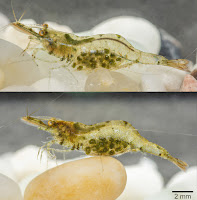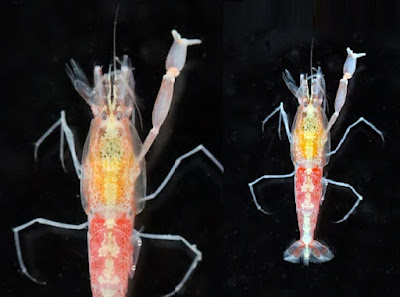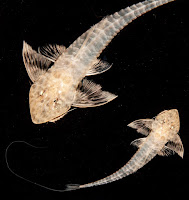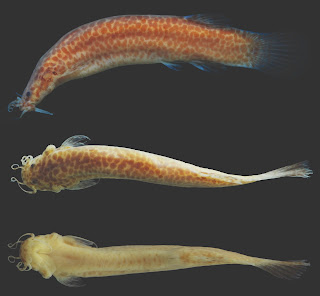 |
| Cyrtodactylus denticulatus Chomdej, Suwannapoom, Pradit, Phupanbai & Grismer, 2023 Spiny-tailed Bent-toed Gecko | ตุ๊กกายฟันเลื่อย || DOI: 10.3897/zookeys.1164.101263 |
Abstract
An integrative taxonomic analysis was used to delimit and diagnose a new species of the Cyrtodactylus brevipalmatus group from Tak Province in western Thailand. Although Bayesian phylogenetic analyses place Cyrtodactylus denticulatus sp. nov. within the brevipalmatus group, the new species is neither nested within nor is it the sister species of any other species in the brevipalmatus group. Furthermore, based on the mitochondrial NADH dehydrogenase subunit 2 gene (ND2) and adjacent tRNAs, it bears an uncorrected pairwise sequence divergence of 7.87–21.94% from all other species in the brevipalmatus group. Cyrtodactylus denticulatus sp. nov. is differetiated from all other species in the brevipalmatus group by having a number of unique charateristics such as denticulate ventrolateral body folds and ventrolateral subcaudal ridges, characters not seen in any other species of the group (n = 51 individuals). Additionally, based on a multiple factor anlaysis, C. denticulatus sp. nov. does not overlap with any other species in multivariate space. The discovery of C. denticulatus sp. nov. underscores the unrealized diversity of upland ecosystems across Thailand and the urgent need for increased exploration and conservation of these unique imperiled montane refugia, especially in this era of climate change.
Keywords: Bent-toed gecko, conservation, Indochina, integrative taxonomy, Southeast Asia, systematics
 |
| Photograph of the living holotype of Cyrtodactylus denticulatus sp. nov. AUP-00680 from the Chao Doi waterfall, Mae Meoi, Tha Song Yang District, Tak Province, Thailand. |
Cyrtodactylus denticulatus sp. nov.
Suggested common name: Spiny-tailed Bent-toed Gecko
Suggested Thai common name: ตุ๊กกายฟันเลื่อย Tuk Kay Fun Leuy
ตุ๊กกายหางซี่เลื่อย
Cyrtodactylus sp. 10: Chomdej et al. 2021: 11; Grismer et al. 2021: 725, 2022a: 247, 2022b: 111; 2023: 95.
Diagnosis: Cyrtodactylus denticulatus sp. nov. is tentatively separated (see below) from all other species of the brevipalmatus group by the combination of having nine supralabials, nine infralabials, 20 paravertebral tubercles, 19 rows of longitudinally arranged tubercles, 42 transverse rows of ventrals, 158 longitudinal rows of ventrals, nine expanded subdigital lamellae on the fourth finger, 11 unexpanded subdigital lamellae on the fourth toe, 19 total subdigital lamellae on the fourth toe; nine expanded subdigital lamellae on the fourth finger, ten unexpanded subdigital lamellae on the fourth finger, 19 total subdigital lamellae on the fourth finger; 16 total number of enlarged femoral scales, 20 total number of femoral pores in the male specimen; 13 precloacal pores in the male specimen; 16 enlarged precloacals; enlarged femorals and enlarged precloacals not continuous; proximal femorals smaller than distal femorals; tubercles on forelimbs and flanks nearly same size as those on body; ventrolateral body fold weakly denticulate; spinose paravertebral rows; row of large dorsolateral caudal tubercles; wide ventrolateral caudal fringes; ventrolateral caudal fringes composed scales of different size; small longitudinal ventrolateral subcaudal ridges; tail square in cross-section; no slightly enlarged unpaired medial subcaudals; subcaudals not posteromedially furrowed; SVL 69.5 mm; three dark transverse body bands (Tables 2–4).
Distribution: Cyrtodactylus denticulatus sp. nov. represents the northwestern-most species of the brevipalmatus group. At present, it is known only from the type locality at Chao Doi waterfall, Tha Song Yang District, Tak Province, western Thailand (Fig. 1).
Etymology: The specific epithet denticulatus is given as a noun in apposition, meaning “denticulate” or with small teeth, a reference to bearing small tooth-like dorsolateral and ventrolateral caudal tubercles and denticulate ventrolateral body folds.
Siriwadee Chomdej, Chatmongkon Suwannapoom, Waranee Pradit, Apichaya Phupanbai and L. Lee Grismer. 2023. A New Species of the Cyrtodactylus brevipalmatus group (Squamata, Gekkonidae) from Tak Province, northwestern Thailand. ZooKeys. 1164: 63-88. DOI: 10.3897/zookeys.1164.101263













































